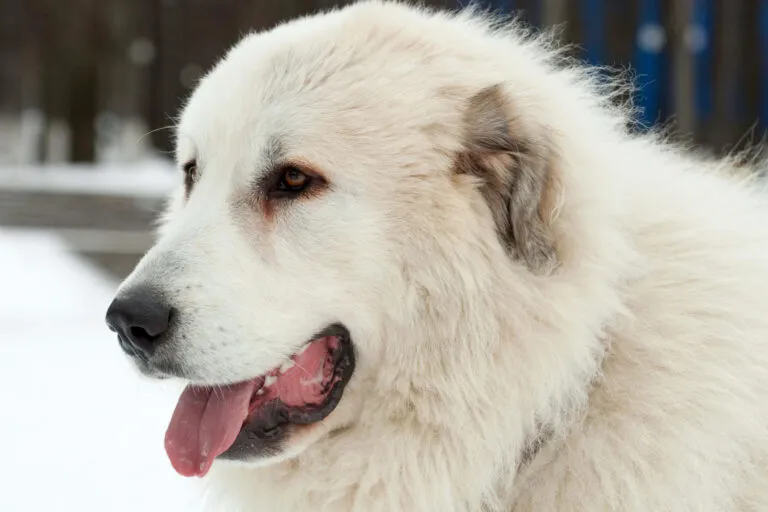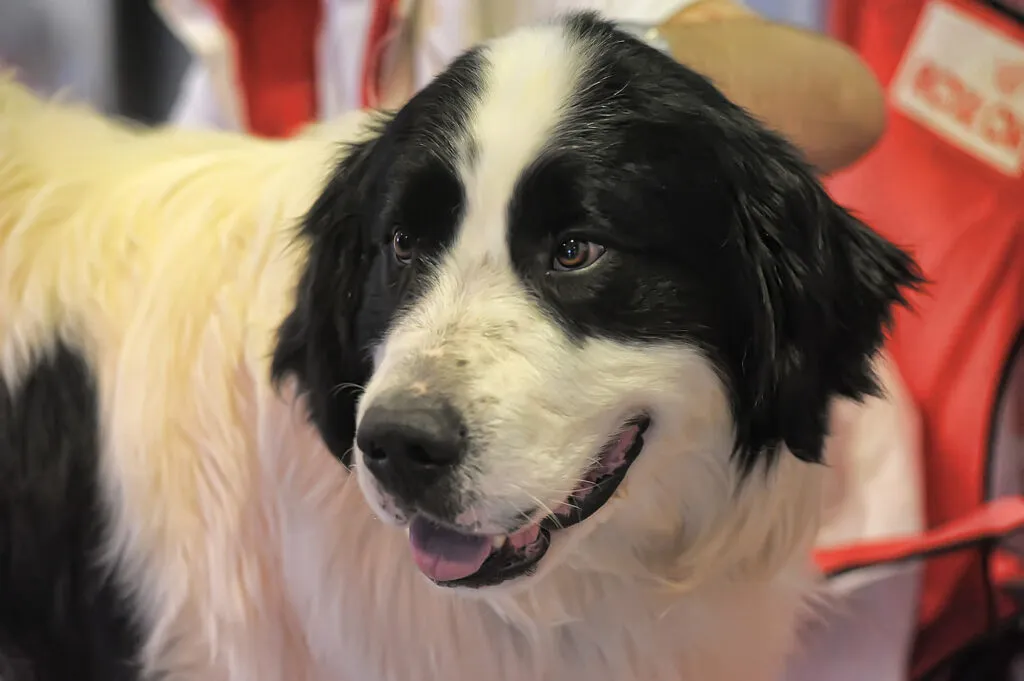Medium Size Poodle
Biting cold, icy wind or scorching sun: Even the harshest weather won't deter this robust mountain dog from its duties. This exceptional guardian of homes, farms, and sheep herds has always been accustomed to the highest demands and remains unshaken.

© Daria Filiminova / stock.adobe.com
Though seldom used as flock guardians today, the Pyrenean Mastiff retains its strength, courage, and calm intelligence, reflecting its proud heritage.
Despite the fact that Pyrenean Mastiffs are now rarely used as flock guardians, they have retained the key traits of their past role. Power, courage, endurance and intelligence, as well as loyalty and calmness, define this imposing breed. These confident dogs are aware of their strength and don’t feel the need to prove it.
Their impressive appearance, powerful and deep bark, and vigilant gaze are enough to command respect. Excessive aggression is utterly foreign to this gentle giant and would be unsuitable for its original job as a flock guardian.
A dog that blindly attacks anything in its path would not only pose a danger to the herd and the shepherd but also to itself. The role of a flock guardian is to protect and stay loyal to its herd. While it must drive away threats, it must always keep an eye on the herd. The risk of getting injured in a fight is only taken if absolutely necessary.
The intelligent Pyrenean Mastiff can assess whether a real threat exists or if a simple show of dominance is sufficient. Despite their determination and courage, they are initially calm and composed when evaluating a situation.
Thanks to their friendly and good-natured disposition, these large mountain dogs can even make good family pets. They are extremely people-friendly, social, and have a high tolerance level. They love playing with children and are patient and forgiving with them. They also get along well with other dogs and pets.
However, they are not dogs that follow commands blindly and gaze up adoringly at their owner. The Mastín del Pirineo is used to acting independently as flock guardians. Left alone with the sheep for long periods, they have learned to make their own decisions.
Their responses have always been more instinctual than following a shepherd’s commands. Absolute obedience goes against the nature of the Pyrenean Mastiff, which views its owner more as a partner than a “pack leader”.
Although the Mastín del Pireneo may consider itself an equal partner, its size makes it anything but. Standing, it can easily reach its owner’s hip, with males being at least 77 cm tall. Females, naturally smaller, must have a min. height of 72 cm at the withers but should ideally be taller than 75 cm.
Regardless of gender, the Pyrenean Mastiff is undoubtedly a “very large dog of above-average format”, as described by the FCI standard. Its proportions are harmonious, and its body is strong and muscular. Despite its mass, the mountain dog never appears clumsy or sluggish. As a flock guardian that accompanied herds for days across the Pyrenees’ mountains and valleys, it still has immense endurance. Its preferred gait is a trot.
The bristly, harsh fur is approx. 6 to 9 cm long, and its muscular body is apparent. Longer hairs are found on the shoulders, neck, belly, and rod, as well as the rear of the legs. The coat is very dense and thick, making it highly weather-resistant. Essential for surviving in the sometimes freezing mountain elevations.
Its resilient coat is primarily white, with darker masks. Permissible spots, the same colour as the mask, should stand out clearly from the white base, ideally well-defined. Acceptable colours include medium grey, intense golden yellow, brown, black, grey-silver, light beige, sandy and marbled. The preferred colour per FCI standards is pure white (snow-white). The coat should also be as light as possible, ideally white. A white-yellow base or reddish spots are not accepted.
The spotted, triangular ears of the Mastiff hang down, lying flat in a relaxed state. When alert, they lift slightly away from the cheeks. The strong rod, lowered to the height of the hocks at rest, curves upwards like a sabre with a hook at its tip when excited or in motion. The almond-shaped hazel eyes and straight nose complete the noble appearance of this imposing mountain dog.
 © Evdoha / stock.adobe.com
© Evdoha / stock.adobe.com
Originally, these dogs lived on both the French and Spanish sides of the Pyrenees. When the first breed standards for flock guardians were established, Spain and France couldn’t agree on a joint version. As a result, there are now two standards: one for the Chien de Montagne des Pyrénées (Pyrenean Mountain Dog) on the French side and another for the Mastín del Pirineo (Pyrenean Mastiff). The standards are very similar, with minor differences.
The ancestors of both breeds likely lived over 3,000 years ago on the Iberian Peninsula. Nomadic tribes used these imposing giants as flock guardians to protect their precious sheep herds from wolves and bears. The distribution area stretched from the Bay of Biscay to the Golfe du Lion. Depending on the season, the nomads drove their herds to high pastures or deep valleys.
The dogs had to withstand extreme temperature differences and harsh weather conditions. Besides robust health, these attractive dogs needed power, courage, endurance, and vigilance. They operated independently, relying on their intelligence and instincts to respond to different situations. A reckless and aggressive dog was unsuitable for such a demanding role. A good flock guardian had to be vigilant yet controlled and gentle.
As nomads settled and sheep farming ceased to be the primary source of income, interest in the large flock guardians waned. Additionally, the number of bears and wolves decreased, reducing the need for such powerful dogs that required substantial food. During the Spanish Civil War, the financial situation for many people (and breeders) worsened, putting the Iberian giants at risk.
Fortunately, a small number survived as guard dogs on Spanish haciendas, allowing breeders to revive the breed in the mid-20th century. In 1977, the Spanish Club del Mastín del Pirineo was founded. Members searched the Pyrenees for suitable breeding dogs.
Their efforts paid off: In the 70s, there were only 24 registered breed dogs, but interest and numbers increased in the following years. Sweden initiated a targeted breeding programme in the 80s, followed by Finland, Norway, France, and other European countries.
The FCI recognises the breed under standard number 92, categorising the Pyrenean Mastiff in Group 2 (Pinschers and Schnauzers, Molossers, Swiss Mountain Dogs) and Section 2.2 (Mountain Dogs). Since April 2014, the Mastín del Pirineo is also registered in the American Kennel Club’s (AKC) Foundation Stock Service.
While the Pyrenean Mastiff often still guards and defends sheep herds in its native region, outside the mountains, it is primarily kept as a guard and family dog today.
If you’re considering a Pyrenean Mastiff as a family pet, you should carefully evaluate whether keeping such a large, freedom-loving animal is feasible. To ensure the former flock guardian thrives in its new environment, a few basic requirements must be met.
A dog of this size undoubtedly needs a large house with a garden where it can roam freely. An apartment is not suitable for a Pyrenean Mastiff. You should also be aware that its powerful and deep bark can be heard beyond your garden fence. Ample space around your property or pet-loving neighbours is certainly advantageous.
The Mastiff’s guarding instinct is particularly strong at dusk, and strangers approaching the property will be greeted by its resonant voice. This friendly breed should be the centre of your family, participating in daily life and not left with a dog sitter during holidays. It is unsuitable for kennel housing.
Daily walks, with plenty of interaction with other dogs, are ideal for the social Pyrenean Mastiff. And maybe you have room for a second dog in your home?
Furthermore, owning a Mastín del Pirineo means having a dog that doesn’t respond well to strict commands. It obeys out of affection, so training with love, patience, empathy, and gentle consistency will yield the best results. Experienced and caring hands are best suited to guide this unique breed’s character.
Besides space, time and experience, owning a Pyrenean Mastiff also requires sufficient funds. Apart from the purchase price, vet visits and accessoires, don’t underestimate the large amount of food this giant dog consumes. The quality of the food is more important than the quantity.
Depending on gender and size, you’ll need about 1-2 kg of food daily, at least half of which should be meat or offal. While the Spanish mountain dog initially survived on milk and cheese rinds, a varied and nutrient-rich diet contributes significantly to your dog’s health.
The daily feeding amount should be split into at least two meals. Smaller portions are easier to digest and can ideally reduce the risk of certain health issues. Experts believe that joint problems (e.g. hip dysplasia due to rapid growth) and the dreaded gastric torsion can be mitigated with proper nutrition.
Of course, regular care also contributes to your dog’s health. Brushing the fur regularly (approx. twice a week) is sufficient. The longer coat on the trousers and behind the ears requires more attention as it tends to tangles. More frequent combing is needed during the fur shedding seasons (twice a year, in spring and autumn).
If you like the Pyrenean Mastiff, you might also be interested in these breeds:
Fans of the Bearded Collie agree that those who aren't familiar with this dog breed simply have to get acquainted with it. And those who have experienced how a Bearded Collie bolts across meadows with its flowing fur, how it rolls around full of energy and joy and how it attentively and observantly takes into account its owners wishes become simply addicted to this original dog breed and its unique charm.
The Goldendoodle isn't a breed, but a pairing between Golden Retrievers and Medium or Standard Poodles. Marketed as a low-maintenance dog for allergy sufferers, this hybrid is enjoying increasing popularity amongst dog lovers, similar to the Labradoodle.